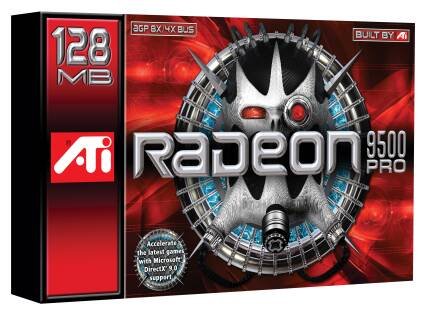
Moving the High End into the Mainstream
ATI's standard mode of business is to move their high end chips to the low end over a period of time. An example of this process is with the original Radeon.
Radeon began its life in 2000 as ATI's high end offering and roughly a year later, upon the introduction of the new DirectX8 chip Radeon 8500, Radeon 7500 was introduced. Radeon 7500 was basically the original Radeon on a smaller silicon process which meant that it could be moved into the mainstream/lowend market position. Roughly a year after the release of Radeon 8500 and 7500 we see the release of the Radeon 9700 PRO and Radeon 9000. This time, whilst Radeon 9700 PRO is a completely new high end chip, targeting DirectX9, Radeon 9000 was a cost reduced version of Radeon 8500, extracting all the key elements of the DX8 to move DirectX8 into the mainstream.

Moving the High End to Mainstream
ATI point out that the 'Ultra High End' market, which ATI categorise by a suggested retail price of above $350, accounts for about 1% of the overall market. In comparison the 'Performance Mainstream' segment, categorised by a pricing of about $200, represents 8 times the number of sales and the sub $100 mainstream sector being 32 times the volume. If we consider that its though that Radeon 9700 PRO has already shipped in the order of 1 Million units in about 3 months we can estimate that ATI are also shifting in the order of 32 Million Radeon 9000's. However, with only the 'Ultra High End' and mainstream markets covered by their latest two entrants ATI has some gaps to plug.
More New Radeons
To fill in the aforementioned product gaps ATI are today announcing some new product variants consisting of: Radeon 9700, Radeon 9500 PRO and Radeon 9500. Lets take a look at the specifications for the new line up, inclusive of current boards
| Radeon | 9700 PRO | 9700 | 9500 PRO | 9500 | 9000 PRO | 9000 | 8500LE |
| DirectX Version | 9 | 9 | 9 | 9 | 8 | 8 | 8 |
| Core Speed | 325 MHz | 275 MHz | 275 MHz | 275 MHz | 275 MHz | 250 Mhz |
230 MHz |
| Memory Speed | 620 MHz | 540 MHz | 540 MHz | 540 MHz | 550 MHz | 500 MHz | 460 MHz |
| Memory Interface | 256 bit | 256 bit | 128 bit | 128 bit | 128 bit | 128 bit | 128 bit |
| Memory Bandwidth | 19.2 GB/s | 17.6 GB/s | 8.6 GB/s | 8.6 GB/s | 8.8 GB/s | 8.8 GB/s | 7.4 GB/s |
| Frame Buffer | 128 MB | 128 MB | 128 MB | 64 MB | 128 / 64 MB | 128 / 64 MB | 64 MB |
| Pixel Pipelines | 8 | 8 | 8 | 4 | 4 | 4 | 4 |
| Pixel Fill Rate | 2.6 Gp/s | 2.2 Gp/s | 2.2 Gp/s | 1.1 Gp/s | 1.1 Gp/s | 1 Gp/s | 0.92 Gp/s |
| Texel Fill Rate | 2.6 Gt/s | 2.2 Gt/s | 2.2 Gt/s | 1.1 Gt/s | 1.1 Gt/s | 1.1 Gt/s | 2.8 Gt/s |
| AA Sample Fill Rate | 15.6 Gs/s | 13.2 Gs/s | 13.2 Gs/s | 6.6 Gs/s | 1.1 Gs/s | 1.1 Gs/s | 0.92 Gs/s |
| Vertex Rate | 325 Mtri/s | 275 Mtri/s | 275 Mtri/s | 275 Mtri/s | 69 Mtri/s | 63 Mtri/s | 57 Mtri/s |
| AGP | 8x | 8x | 8x | 8x | 4x | 4x | 4x |
| Available | Now | Oct | Nov | Oct | Now | Now | Now |
| RRP | $399 | $299 | $199 / €250 |
$179 / €210 |
$129 | $99 | $99 |
As we can see, all the 9700 and 9500 products all have DirectX 9 support and the reason this is because they are all based on the same R300 chip that the high end Radeon 9700 PRO is based on. This means that all the features and all the performance enhancing elements of the 9700 PRO, such as the good FSAA and Anisotropic performance, will filter all the way down into these mainstream markets. Something else to note, is that although Radeon 9500 only utilises 4 of the pixel pipelines from the R300 chip it does still feature all 4 vertex shader engines. For a complete run down of the features and capabilities found in the R300 chip read our ATI Readon 9700 PRO review.
The 8500LE's are still listed in the table because ATI are still selling this product in various places, however they are likely to just be working through their remaining inventory of R200 chips that this is based on.
ATI themselves will be bringing versions of the 'PRO' branded products into the markets that ATI are still operating in as a board vendor, however 3rd party board vendors can bring any of the range of products to the market. Most of the memory types there are suggested to the 3rd part board vendors and its likely that they will initially appear in those configurations, however as board vendors seek for more product differentiation over time its likely that they will vary the memory configurations available.

Moving the High End to Mainstream
